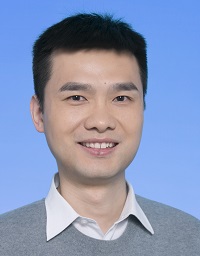 | Jingjin Ding, Ph.D, Prof. Principal Investigator Members of the Youth Innovation Promotion Association, CAS National Laboratory of Biomacromolecules, Institute of Biophysics, CAS Molecular mechanism of pathogen infection and host innate immune defense E-mail: jding(AT)ibp.ac.cn Tel: 010-64888548 Fax: 010-64888548 Zip code: 100101 Chinese personal homepage |
Biography & Introduction
Education & Positions
09/1999-07/2003 B.Sc. in Biotechnology, College of Life Sciences, Wuhan University, Wuhan
09/2003-07/2008 Ph.D in Biochemistry and Molecular Biology, Institute of Biophysics, Chinese Academy of Sciences, Beijing
10/2008-11/2010 Postdoctoral in Structural Biology, Institute of Biophysics, Chinese Academy of Sciences, Beijing
11/2010-12/2011 Research assistant, Institute of Biophysics, Chinese Academy of Sciences, Beijing
01/2012-12/2016 Associate Professor, Institute of Biophysics, Chinese Academy of Sciences, Beijing
04/2013-12/2017 Visiting Scientist, National Institute of Biological Sciences, Beijing
01/2017-Present Professor, Institute of Biophysics, Chinese Academy of Sciences, Beijing
Research Interest
Pathogen infection and host innate immunity are important manifestations of the pathogen-host interaction, in which the key scientific question is to understand the molecular mechanisms of pathogen infection, immune recognition and response. Our group systematically studied the molecular basis of host innate immunity, pathogen infection, and drug resistance, and made significant research achievements that include deciphering the detailed mechanism of pyroptosis in host innate immunity (Nature 2016), dissecting the molecular mechanism of blocking host death receptor signaling by bacterial-effector-mediated arginine GlcNAcylation of death domains (Mol Cell 2019), and uncovering the catalytic mechanism of cephalosporin hydrolysis by NDM-1 encoded by multi-drug resistant superbugs (JACS 2014). We will focus on the direct connections between pathogen infection and host innate immune system. By exploring the precise molecular mechanisms of counteracting host innate immunity by pathogen effector proteins, and sensing pathogen-associated molecular patterns by novel innate immune receptors in response to pathogen infection, a comprehensive mechanistic framework will be established to guide the drug developments for anti-bacteria, immunoregulation, and anti-inflammation.
Selected publications(*Corresponding Authors, # First Authors)
1. Ding, J.*, Pan X, Du L, Yao Q, Xue J, Yao H, Wang DC, Li S*, Shao F*. (2019). Structural and functional insights into host death domains Inactivation by the Bacterial Arginine GlcNAcyltransferase Effector. Mol Cell. 74, 922-35.
2. Ding, J.* & Shao F*. (2018). Growing a gasdermin pore in membranes of pyroptotic cells. EMBO J. 37, e100067.
3. Ding, J. & Shao, F. (2017). SnapShot: The Noncanonical Inflammasome. Cell. 168, 544-4.
4. Ding, J., Wang, K., Liu, W., She, Y., Sun, Q., Shi, J., Sun, H., Wang, D. C.*& Shao, F.* (2016). Pore-forming activity and structural autoinhibition of the gasdermin family. Nature. 535, 111-6.
5. Wang, X., Hou, Y., Deng, K., Zhang, Y., Wang, D. C.* & Ding, J.* (2015). Structural Insights into the Molecular Recognition between Cerebral Cavernous Malformation 2 and Mitogen-Activated Protein Kinase Kinase Kinase 3. Structure. 23, 1087-96.
6. Feng, H.#, Ding, J.#, Zhu, D.#, Liu, X., Xu, X., Zhang, Y., Zang, S., Wang, D. C.* & Liu, W.* (2014). Structural and mechanistic insights into NDM-1 catalyzed hydrolysis of cephalosporins. J Am Chem Soc. 136, 14694-7.
7. Wang, W.#, Ding, J.#, Zhang, Y., Hu, Y.*& Wang, D. C.* (2014). Structural insights into the unique single-stranded DNA-binding mode of Helicobacter pylori DprA. Nucleic Acids Res. 42, 3478-91.
8. Guo, L.#, Ding, J.#, Guo, R., Hou, Y., Wang, D. C.*& Huang, L.* (2014). Biochemical and structural insights into RNA binding by Ssh10b, a member of the highly conserved Sac10b protein family in Archaea. J Biol Chem. 289, 1478-90.
9. Xu, X., Wang, X., Zhang, Y., Wang, D. C.* & Ding, J.* (2013). Structural basis for the unique heterodimeric assembly between cerebral cavernous malformation 3 and germinal center kinase III. Structure. 21, 1059-66.
10. Wang, T.#, Ding, J.#, Zhang, Y., Wang, D. C.*& Liu, W.* (2013). Complex structure of type VI peptidoglycan muramidase effector and a cognate immunity protein. Acta Crystallogr D Biol Crystallogr. 69, 1889-900.
11. Ding, J.#, Wang, W.#, Feng, H., Zhang, Y. & Wang, D. C. (2012). Structural insights into the Pseudomonas aeruginosa type VI virulence effector Tse1 bacteriolysis and self-protection mechanisms. J Biol Chem. 287, 26911-20.
12. Gong, Y.#,Zhu, D.#, Ding, J.#, Dou, C. N., Ren, X., Gu, L., Jiang, T.* & Wang, D. C.*(2011). Crystal structures of aprataxin ortholog Hnt3 reveal the mechanism for reversal of 5'-adenylated DNA. Nat Struct Mol Biol. 18, 1297-9.
13. Ding, J., Wang, X., Li, D. F., Hu, Y., Zhang, Y. & Wang, D. C. (2010). Crystal structure of human programmed cell death 10 complexed with inositol-(1,3,4,5)-tetrakisphosphate: a novel adaptor protein involved in human cerebral cavernous malformation. Biochem Biophys Res Commun. 399, 587-92.
14. Ding, J., Bao, J., Zhu, D., Zhang, Y. & Wang, D. C. (2010). Crystal structures of a novel anti-HIV mannose-binding lectin from Polygonatum cyrtonema Hua with unique ligand-binding property and super-structure. J Struct Biol. 171, 309-17.
From Jingjin Ding,2019-11-22